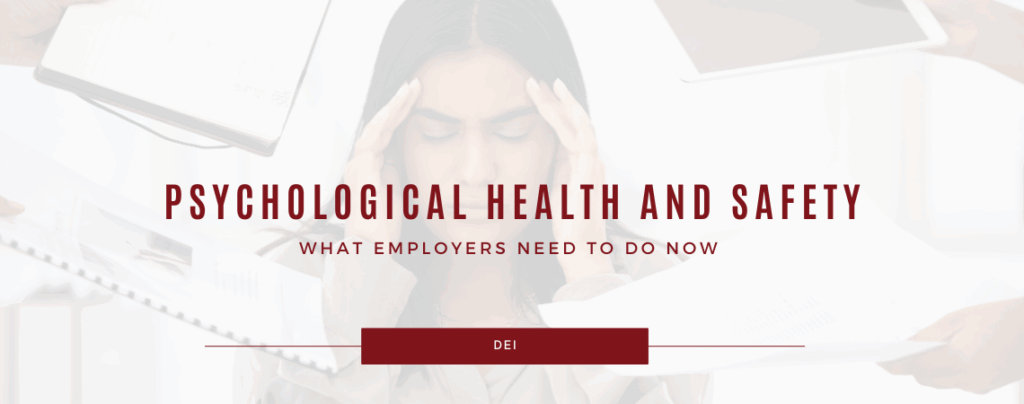
Understanding Invisible Disabilities and Evolving Standards in Occupational Health & Safety
Sometimes, the most significant challenges in the workplace aren’t the loudest ones. They don’t arrive in a cast or come with a doctor’s note. They show up in silence, in someone zoning out during meetings, avoiding eye contact, or just “not seeming like themselves.”
In a breakthrough decision, the Supreme Court of Canada formally recognized what many already know to be true: mental healthis health. It deserves the same care, support, and protection as any other health issue. The case emphasizes that mental safety (and injury to mental health due to bullying and harassment) is equally, if not more critical to a sense of dignity than physical safety. That legal precedent marked a turning point, but for many workplaces, policy and practice are still catching up.
Today, psychological health and safety is increasingly being recognized as a core part of occupational health and safety (OHS). In BC, WorkSafeBC outlines that employers are responsible for addressing workplace factors that are within their control, responsibility, or influence, including those that contribute to psychological harm.
This shift means more oversight, clearer expectations, and real consequences when psychological safety is neglected, including formal investigations, financial penalties, and impacts on team wellbeing.
Invisible Disabilities in the Workplace
Anxiety. Depression. PTSD. Chronic stress.
These are just a few examples of mental health conditions that can shape how a person moves through the world, even if no one else notices. The truth is, no two people experience these conditions the same way. That’s part of what makes them so easy to overlook, and so often misunderstood.
Conditions that aren’t immediately visible but still impact how a person shows up at work – emotionally, mentally, or physically – are known as invisible disabilities. They can include chronic pain, neurological differences, autoimmune disorders, and more.
Each person’s experience is unique, which is why awareness, empathy, and proactive support matter.
No one should have to prove what they’re experiencing just to be believed. That burden reinforces the stigma – and makes it harder for people to access the support they need.
Embracing a Mindset Shift
Creating a safer, healthier workplace begins with rethinking how we see mental health.
It means noticing changes, not questioning them. It means listening when someone opens up, not analyzing or doubting. It means designing systems that support people, even when their needs aren’t visible.
When we shift from a mindset of “fixing” to one of understanding, we create space for people to show up as they are, without fear of judgment or consequence. Prioritizing psychological safety the same way we do physical safety in our workplaces enables us to build a foundation of trust that enables real connection, collaboration, and care.
Why This Matters: Legally and Practically
Creating a psychologically safe workplace is a core responsibility of every employer.
Here’s what’s at stake when that responsibility is ignored:
- Employee Wellbeing: Employers are responsible for preventing harm; not just physical, but emotional and psychological, too.
- Team Trust & Retention: When people don’t feel safe or supported, they disengage (or leave).
- Reputation & Culture: How you show up for your team shapes how they see you, how they work, and whether they stay.
- Avoidable Consequences: While financial penalties from WorkSafeBC (up to $759,368) for BC employers specifically are real, the bigger cost is losing your people’s trust.
Where Employers Can Start
You don’t need a perfect policy to take the first step.
Start here:
- Review your policies with a critical lens. Do your processes account for invisible needs? Are you unintentionally creating barriers? Start with a basic audit grounded in accessibility and inclusion.
- Equip your leaders. Train managers to recognize signs of mental health challenges and respond with empathy, not skepticism. A supportive leader can make all the difference.
- Choose your words carefully. Language shapes culture. Use terms that normalize mental health conversations and avoid reinforcing stigma.
- Make asking for help easy and consistent. Whether it’s a trusted point of contact, a formal accommodation process, or anonymous support options, employees need clear, reliable ways to be heard and access support.
Small shifts add up. Start where you are – and commit to the journey. At its core, this isn’t about compliance but about a positive and supportive workplace culture. When employers take mental health seriously, it transforms how people show up in the workplace.
Want to take your next step toward a more supportive workplace?
Read our blog on 5 Ways to Support Your Team’s Mental Health for practical strategies you can start using today.
Not sure if your workplace meets the mark on psychological safety?